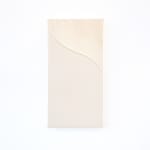GJ Kimsunken
Figuration 22. 13 (shoulder), 2022
Oil on canvas
19 1/2 x 10 in
50 x 25 cm
50 x 25 cm
GK0058
Copyright The Artist
Further images
-
(View a larger image of thumbnail 1
)

-
(View a larger image of thumbnail 2
)

-
(View a larger image of thumbnail 3
)

-
(View a larger image of thumbnail 4
)

-
(View a larger image of thumbnail 5
)

-
(View a larger image of thumbnail 6
)

-
(View a larger image of thumbnail 7
)

-
(View a larger image of thumbnail 8
)

-
(View a larger image of thumbnail 9
)

Kimsunken’s non-descriptive figure paintings occupy a singular space between representation and abstraction. His repetitive and rigorous painting process emphasizes the physical properties of oil paint, with the resultant works deeply...
Kimsunken’s non-descriptive figure paintings occupy a singular space between representation and abstraction. His repetitive and rigorous painting process emphasizes the physical properties of oil paint, with the resultant works deeply rooted in the history of the medium.
In his work, Kimsunken asks questions about human existence: who are we, why are we and what are we for? Generally, he titles each work Figuration. The new works represent a significant departure from his previous series and are an exciting development in his continuing interest in and investigation into human figuration. Kimsunken still methodically primes the canvas with gesso, which he then covers in multiple layers of oil paint, giving the surfaces an otherworldly luminescence, as well as substantial weight. Despite his compositions’ reductive, abstract appearance – achieved by scraping away paint from the canvas – Kimsunken’s paintings represent the human figure.To the artist, this method is very much the most direct way of mark-making and is related to the core theme of his work - arousing the human condition - leading to the question of human salvation.
By isolating part of the human figure, one at a time, Kimsunken encourages the viewer to use imagination to fill the blank wall space, where their own figure stands. Questions of spatial relationship are necessarily a part of viewing Figuration 22. 13 (shoulder), in response to one’s own figure and other bodies in space. Through radical and tactful placement of intimately sized canvases, Kimsunken invites the viewer into a transcendental experience which affirms one’s own sense of presence.
In his work, Kimsunken asks questions about human existence: who are we, why are we and what are we for? Generally, he titles each work Figuration. The new works represent a significant departure from his previous series and are an exciting development in his continuing interest in and investigation into human figuration. Kimsunken still methodically primes the canvas with gesso, which he then covers in multiple layers of oil paint, giving the surfaces an otherworldly luminescence, as well as substantial weight. Despite his compositions’ reductive, abstract appearance – achieved by scraping away paint from the canvas – Kimsunken’s paintings represent the human figure.To the artist, this method is very much the most direct way of mark-making and is related to the core theme of his work - arousing the human condition - leading to the question of human salvation.
By isolating part of the human figure, one at a time, Kimsunken encourages the viewer to use imagination to fill the blank wall space, where their own figure stands. Questions of spatial relationship are necessarily a part of viewing Figuration 22. 13 (shoulder), in response to one’s own figure and other bodies in space. Through radical and tactful placement of intimately sized canvases, Kimsunken invites the viewer into a transcendental experience which affirms one’s own sense of presence.
110
de
385








